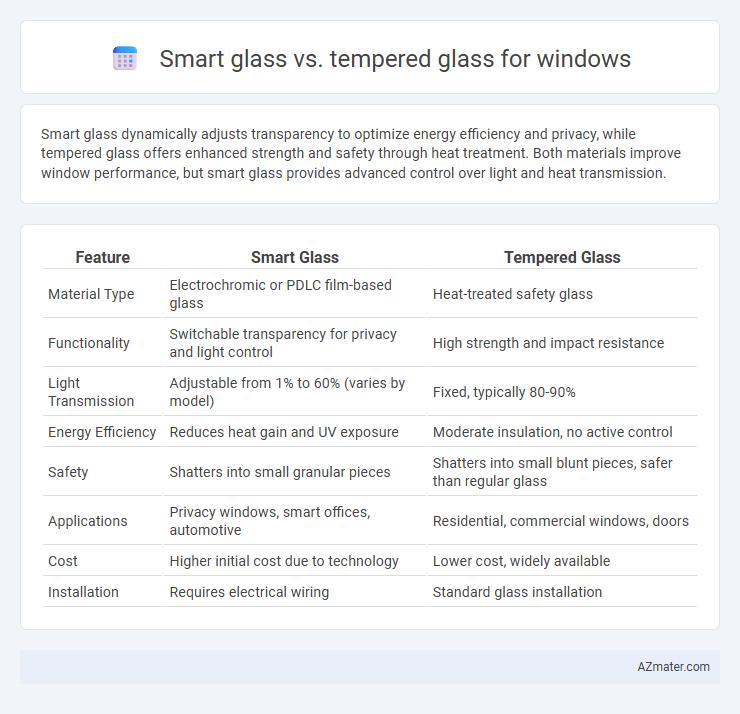Smart glass dynamically adjusts transparency to optimize energy efficiency and privacy, while tempered glass offers enhanced strength and safety through heat treatment. Both materials improve window performance, but smart glass provides advanced control over light and heat transmission.
Table of Comparison
| Feature | Smart Glass | Tempered Glass |
|---|---|---|
| Material Type | Electrochromic or PDLC film-based glass | Heat-treated safety glass |
| Functionality | Switchable transparency for privacy and light control | High strength and impact resistance |
| Light Transmission | Adjustable from 1% to 60% (varies by model) | Fixed, typically 80-90% |
| Energy Efficiency | Reduces heat gain and UV exposure | Moderate insulation, no active control |
| Safety | Shatters into small granular pieces | Shatters into small blunt pieces, safer than regular glass |
| Applications | Privacy windows, smart offices, automotive | Residential, commercial windows, doors |
| Cost | Higher initial cost due to technology | Lower cost, widely available |
| Installation | Requires electrical wiring | Standard glass installation |
Introduction to Smart Glass and Tempered Glass
Smart glass, also known as switchable glass, utilizes technology that allows it to change its light transmission properties, offering dynamic control over privacy, glare, and heat. Tempered glass is a type of safety glass processed through controlled thermal or chemical treatments to increase its strength, making it resistant to impact and thermal stress. Both materials serve distinct purposes in window applications, with smart glass focusing on adaptive functionality and tempered glass emphasizing durability and safety.
How Smart Glass Works
Smart glass uses electrochromic, thermochromic, or photochromic technologies to change its opacity or tint in response to electrical voltage, temperature, or light intensity. This dynamic control allows smart glass windows to improve energy efficiency by regulating solar heat and glare while maintaining privacy. Unlike tempered glass, which is designed solely for strength and safety through heat treatment, smart glass offers adaptive functionality for enhanced comfort and sustainability.
Understanding Tempered Glass
Tempered glass is heat-treated to increase its strength, making it four to five times stronger than regular glass and highly resistant to impact and thermal stress. It shatters into small, blunt pieces upon breakage, enhancing safety for window applications compared to standard glass. This durability and safety make tempered glass a preferred choice for windows in residential, commercial, and automotive settings where both strength and safety are critical.
Key Differences Between Smart Glass and Tempered Glass
Smart glass utilizes electrochromic or photochromic technology to change its transparency based on electric voltage or light exposure, offering dynamic control over privacy and solar heat gain. Tempered glass is heat-treated to increase strength and shatter into small, less harmful pieces upon impact, providing enhanced safety and durability. Key differences include smart glass's adaptive light modulation capabilities versus tempered glass's focus on structural integrity and safety performance.
Energy Efficiency: Which Glass Performs Better?
Smart glass outperforms tempered glass in energy efficiency by dynamically controlling solar heat gain and natural light transmission, reducing the need for artificial cooling and lighting. Tempered glass, while offering strength and safety benefits, lacks the adaptive properties that optimize thermal insulation throughout the day. Incorporating smart glass in windows can lead to significant energy savings and enhanced indoor comfort compared to traditional tempered glass.
Privacy Features: Smart Glass vs Tempered Glass
Smart glass offers dynamic privacy control by electronically switching from transparent to opaque, enabling instant modulation of window opacity without external coverings. Tempered glass, known for its strength and safety, provides no inherent privacy features and remains fully transparent unless paired with additional frosted films or curtains. Smart glass's advanced privacy functionality makes it ideal for settings requiring flexible, on-demand privacy compared to the static transparency of tempered glass.
Safety and Security Comparison
Smart glass offers enhanced safety features by instantly switching between transparent and opaque states, preventing break-ins through visual deterrence and controlled visibility, while tempered glass provides robust physical security with its shatter-resistant composition that breaks into small, blunt pieces reducing injury risks during impact. Tempered glass is highly valued for its ability to withstand high impact forces, making it ideal for secure window installations, whereas smart glass integrates advanced technology to improve occupant privacy and reduce potential entry points for intruders. Combining smart glass with tempered layers can significantly elevate window safety and security, blending physical durability with adaptive control over visibility.
Cost Analysis: Upfront and Long-term Expenses
Smart glass for windows typically incurs higher upfront costs ranging from $50 to $100 per square foot due to advanced technology and installation requirements, while tempered glass averages $20 to $40 per square foot. Long-term expenses for smart glass include potential maintenance of electronic components and higher energy savings, which can reduce cooling and heating costs by up to 25%. Tempered glass requires minimal maintenance but lacks energy efficiency benefits, potentially leading to higher utility bills over time.
Aesthetic and Design Flexibility
Smart glass offers superior aesthetic appeal by seamlessly transitioning between transparent and opaque states, enabling dynamic light control and enhanced privacy without additional window treatments. Tempered glass provides a sleek, uniform appearance with excellent strength but lacks the adaptive qualities of smart glass, limiting design flexibility. The integration of smart glass in modern architecture allows for innovative design possibilities, including customizable shading and energy-efficient solutions that tempered glass cannot match.
Choosing the Right Glass for Your Window Needs
Smart glass offers dynamic control over light and privacy by adjusting its opacity with an electric charge, making it ideal for energy efficiency and modern design. Tempered glass provides superior strength and safety by undergoing thermal treatment, making it resistant to impact and shattering. Choosing the right glass depends on prioritizing features like energy savings and privacy with smart glass or durability and safety with tempered glass for your specific window needs.

Infographic: Smart glass vs Tempered glass for Window
 azmater.com
azmater.com